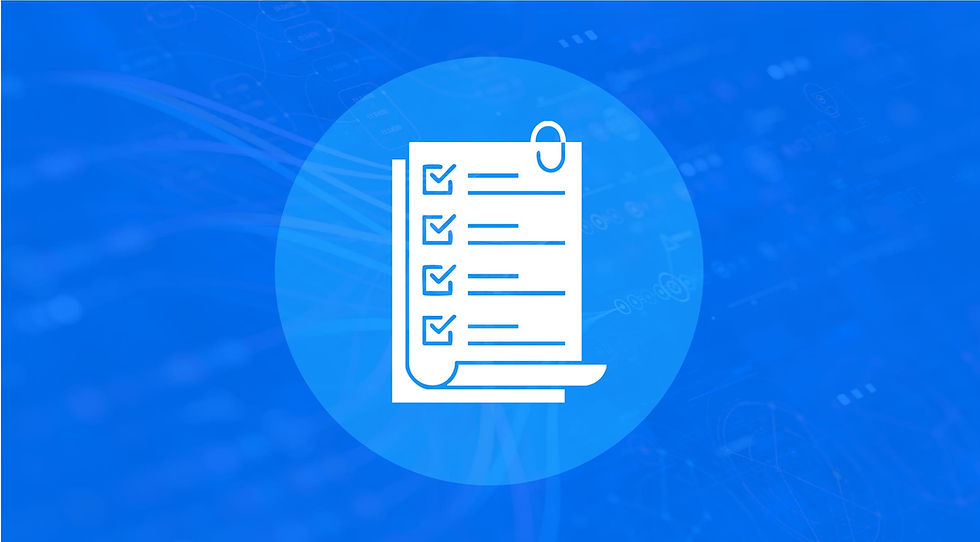Beyond Checkboxes: Why Real-Time Compliance Is the Future of Cybersecurity
- bakhshishsingh
- May 28
- 3 min read
In an age where data breaches and regulatory fines dominate headlines, cybersecurity compliance is no longer a luxury—it’s a mandate. Yet, many organizations still rely on outdated, checklist-based methods to manage their compliance posture. While these checklists offer a helpful starting point, they fall woefully short in addressing the complexities of modern digital environments.
If your business is operating in hybrid environments—spanning on-premise, cloud, and edge—then it’s time to move beyond checkbox compliance and adopt a real-time, risk-aligned approach.
The Limitations of Traditional Compliance

Most businesses still treat compliance as a project—an annual or quarterly ritual marked by spreadsheets, static audits, and last-minute documentation sprints. The problem? Compliance isn’t static, and neither are today’s cyber threats.
From ISO 27001 and GDPR to NIS2 and sector-specific standards, regulations are constantly evolving. Each new rule introduces additional layers of complexity. A reactive, checklist-based approach struggles to keep pace with these changes. By the time evidence is gathered and documentation submitted, your compliance posture may already be outdated.
Checklist Culture Fails in a Dynamic Threat Landscape
While checklists are good for consistency, they’re inherently backward-looking. They confirm what was done, not what needs to be done next. They’re useful for organizing tasks, but ineffective in identifying real-time threats like:
Zero-day vulnerabilities
Unauthorized access attempts
Unpatched software
Misconfigured cloud resources
When you treat compliance as a one-time box-checking activity, you open the door to persistent risk—and possibly hefty fines or breaches.
Real-Time Compliance: What It Means and Why It Matters

Real-time compliance is exactly what it sounds like: continuously monitoring your security posture against evolving regulatory requirements and internal risk thresholds. It shifts compliance from a reactive to a proactive discipline, empowering your organization to stay audit-ready and cyber-resilient every day—not just during audit season.
Real-Time Monitoring Offers Three Core Benefits:

1. Stay Cyber Ready
Real-time compliance allows you to detect and respond to security risks like unpatched systems, suspicious user activity, or unauthorized changes the moment they arise. This instant visibility ensures you’re never caught off-guard.
2. Make Compliance Actionable
Rather than gathering evidence weeks after the fact, real-time tools consolidate compliance data across systems—network logs, endpoint security, identity access controls—into a single, accessible dashboard. This makes audits faster, reporting easier, and tracking more reliable.
3. Streamline Security Management
Automation is a key advantage of real-time compliance. By integrating with your security and IT systems, real-time compliance tools can generate reports, flag anomalies, and initiate remediation workflows—reducing manual effort and human error.
Evolving Regulations Require Evolving Strategies

As the regulatory landscape continues to grow in complexity, businesses must adopt more agile compliance strategies. Regulations such as:
GDPR (General Data Protection Regulation) for data privacy
ISO 27001 for information security management
NIS2 (EU Directive) for critical infrastructure resilience
…each introduce overlapping but distinct requirements. Staying compliant with multiple frameworks requires real-time insight into what’s happening across your tech ecosystem—not just what should be happening.
Real-time compliance ensures that as new standards emerge, your posture evolves in tandem.
Aligning Security with Business Strategy
One of the most overlooked benefits of real-time compliance is its ability to align security efforts with broader business goals. Traditional compliance often operates in a silo—disconnected from business operations and viewed as a necessary burden. Real-time compliance changes that by:
Fostering transparency with stakeholders and clients
Demonstrating trustworthiness to partners and regulators
Gaining competitive advantage through demonstrable resilience
When compliance becomes part of your business strategy rather than a reactive checklist, it transforms from a cost centre into a value driver.
Why Now Is the Time to Act
The cost of non-compliance is steep: data breaches, operational disruptions, reputational damage, and regulatory penalties. Yet the cost of transforming to a real-time compliance model has never been lower, thanks to:
Advanced monitoring tools
Cloud-native security platforms
AI-driven threat detection
Automated evidence collection
Organizations that invest in real-time compliance not only mitigate risk but also reduce the operational burden of traditional audits.
Final Thoughts: Simplifying Compliance Without Compromising Security
Yes, compliance is complex. But simplifying it doesn’t mean dumbing it down—it means modernizing how you manage it. Real-time compliance is not just about passing audits; it’s about embedding security into the fabric of your business.
Move beyond checklists. Embrace continuous compliance. Because in today’s world, being compliant once a year isn’t enough—you need to be compliant every day.





Comments